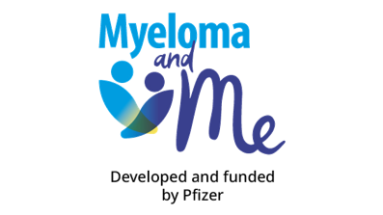How dietary choices may help during multiple myeloma treatment
The information provided is for educational purposes only and is not intended to replace discussions with a healthcare provider.
1. Why is diet important in multiple myeloma?1,2,3,4,5,6,7
People living with multiple myeloma who are undergoing treatment may have problems with their digestion. These issues can be very unpleasant and can cause discomfort. Examples include nausea (feeling sick), vomiting, loss of appetite, bowel disturbances (diarrhea or constipation), sore or inflamed mouth and gut (mucositis), change in taste, loss of muscle mass, and dehydration. If you experience these symptoms, it is important to talk to your healthcare team because they may be able to make changes to your treatment to help make you more comfortable. Making changes to your diet may also reduce these symptoms1:
- Nausea: Try to eat small, frequent meals, and avoid fatty or fried foods
- Loss of appetite: It is vital to drink enough water and other fluids
- Constipation: Increase your fluid and fiber intake
You should speak to your healthcare team if you’re taking any new medication or considering adding any vitamin or mineral supplements to your diet. Some supplements that were OK to take before a diagnosis of multiple myeloma may not be recommended to take after.
2. Easing symptoms of multiple myeloma with dietary choices
In people with multiple myeloma, there is a high level of harmful plasma cells in the bone marrow. These cells increase the production of a protein called ‘M-protein’, which frequently leads to high calcium levels, kidney disease, anemia, and weak bones.8
High calcium
Calcium is a mineral that makes bones stronger and helps bones to grow. Consistently higher than normal levels of calcium in the blood can have a negative effect on the body, and can lead to kidney damage, tiredness or weakness, and bone pain. If your calcium levels are increased but not high enough to cause symptoms, your doctor may recommend drinking extra fluid to help flush extra calcium out of the body.9
Kidney disease
The extra protein and calcium in the bloodstream cause more work for the kidneys, which may lead to kidney damage.10 If your doctor is concerned about how well your kidneys are working, they may suggest limiting your intake of one or more of the foods below11:
- Foods high in potassium: Such as oranges, bananas, spinach, zucchini/courgettes, and peaches
- Foods high in phosphorus: Such as cheese, wheat bread, peanut butter, nuts, and seeds
- Foods high in sodium: Such as processed foods, packaged snacks, condiments, salad dressings, sauces, and restaurant or takeout food
Anemia
Anemia means that you have a low number of red blood cells in your blood, and this can make you feel tired or weak.12 Anemia can be caused by low levels of iron, folate, and vitamin B-12. People with multiple myeloma and anemia may benefit from the following foods to boost levels of13:
- Iron: Such as red meat, clams, liver, sardines, beans, chickpeas, lentils, nuts, and leafy greens
- Folate: Such as beef liver, asparagus, black-eyed peas, lentils, broccoli, beans (cooked from dried), and spinach
- Vitamin B-12: Such as beef, liver, clams, fish, poultry, eggs, dairy, fortified breakfast cereals or non-dairy milk, and nutritional yeast
Weak bones14,15,16
In people with multiple myeloma, bones often become thinner and weaker (known as osteoporosis), and holes begin to appear (known as lytic lesions). These weakened bones have a higher risk of breaking. To improve bone strength, your healthcare team may suggest foods with higher levels of vitamin D. Vitamin D is a nutrient that the body needs to help muscles move, and it also helps bones to absorb the calcium they need to be strong and healthy. Foods that are high in Vitamin D include beef liver, fortified cereal, milk or orange juice, fish (such as salmon, sardines, swordfish, or cod liver oil), and egg yolks.15 Your healthcare team may also suggest eating calcium-rich foods such as milk, cheese, and yogurt, which will also help to strengthen bones.
Before making any major changes to your diet, or considering taking supplements such as vitamins or calcium, it is important to speak to your healthcare team first to discuss your individual needs. This information is for educational purposes only.
3. Higher infection risk
The role of the immune system is to fight disease caused by germs such as bacteria and viruses and remove them from the body.17 People with multiple myeloma may have weakened immune systems. In addition, treatment for multiple myeloma can reduce the function of the immune system. It is therefore important to handle and cook food carefully, and avoid undercooked food (particularly meat), sushi, raw eggs, and unpeeled fruits and vegetables – all of these can carry bacteria and lead to infection
To safely cook and prepare food13:
- Do not leave perishable food out at room temperature
- Wash all produce thoroughly
- Do not eat foods past their ‘best before’ or ‘use by’ date
- Maintain high levels of kitchen hygiene, such as storing raw meats and poultry separately in the refrigerator
References
- International Myeloma Foundation. Gastrointestinal Problems. Available here. Accessed 01 March 2023.
- National Cancer Institute. Gastrointestinal Complications (PDQ®) – Patient Version. Available here. Accessed 01 March 2023.
- Grazziutti ML, et al. Oral mucositis in myeloma patients undergoing melphalan-based autologous stem cell transplantation: incidence, risk factors and a severity predictive model. Bone Marrow Transplant. 2006;38(7):501-506.
- Blood Cancer. Treatment Side Effects – Changes to Taste and Appetite. Available here. Accessed 01 March 2023.
- Williams A, et al. Prevalence and Significance of sarcopenia in multiple myeloma patients undergoing autologous hematopoietic cell transplantation. Bone Marrow Transplant. 2021;56(1):225-231.
- National Comprehensive Cancer Network. Clinical Practice Guidelines in Oncology. Multiple Myeloma 2021. Available here. Accessed 1 March 2023
- Healthline. How Does Hypercalcemia Complicate Multiple Myeloma? Available here. Accessed 01 March 2023.
- El Arfani C, et al. Metabolic features of multiple myeloma. Int J Mol Sci. 2018;19(4):1200.
- My Myeloma Team. Understanding Hypercalcemia and Multiple Myeloma. Available here. Accessed 01 March 2023.
- Healthline. Diet Tips for Multiple Myeloma. Available here. Accessed 01 March 2023.
- My Myeloma Team. Multiple Myeloma Diet and Nutrition Tips. Available here. Accessed 01 March 2023.
- Myeloma UK. Fatigue and Myeloma – Symptoms and Complications Infoguide. Available here. Accessed 01 March 2023.
- Medical News Today. What to Eat if You Have Multiple Myeloma. Available here. Accessed 01 March 2023.
- International Myeloma Foundation. Bone Disease. Available here. Accessed 01 March 2023.
- My Myeloma Team. Vitamin D and Myeloma: Benefits and Uses. Available here. Accessed 01 March 2023.
- WebMD. Bone Health and Multiple Myeloma. Available here. Accessed 01 March 2023.
- Informed Health. How Does the Immune System Work? NCBI Bookshelf. Available here. Accessed 01 March 2023.
PP-UNP-GBR-3977. April 2023









